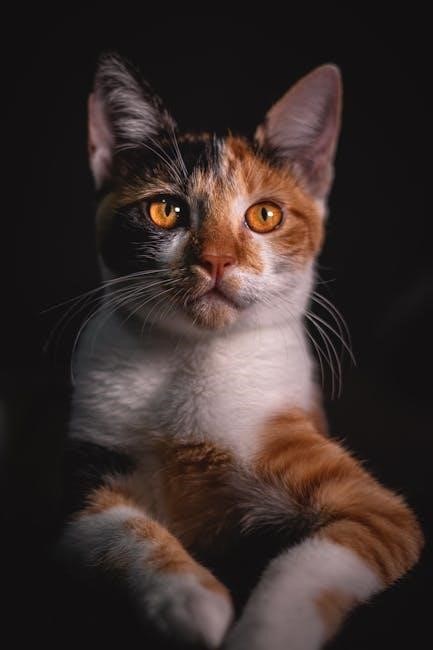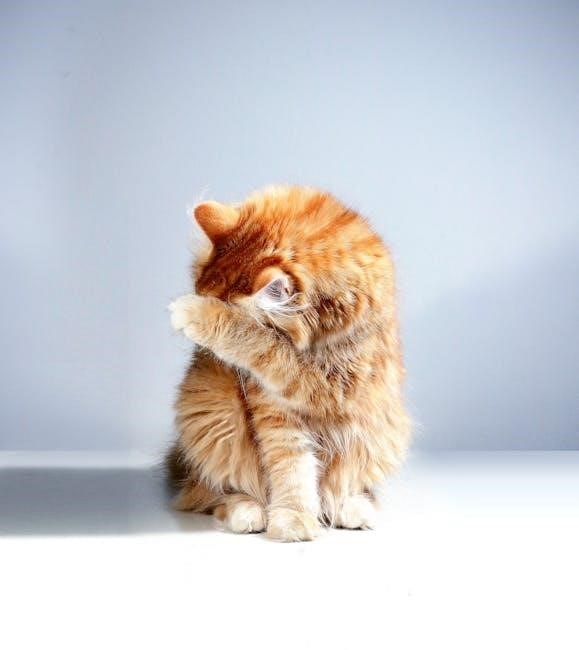trazodone for cats dosage chart by weight pdf
Trazodone is an antidepressant prescribed by veterinarians to manage anxiety and behavioral issues in cats. It works by increasing serotonin levels in the brain.
Trazodone is an antidepressant medication sometimes prescribed by veterinarians for use in cats. It’s primarily used to manage anxiety and behavioral problems, especially those related to stress from vet visits, travel, or loud noises. The medication works by increasing serotonin levels in the brain, which can help to promote a sense of calm and reduce anxiety. It is a serotonin antagonist and reuptake inhibitor. While Trazodone is approved for use in humans, its use in cats is considered “off-label,” meaning it’s prescribed based on a veterinarian’s professional judgment and experience. Because dosing short-acting anxiety and sedative medications in veterinary patients is often based on a trial and error process, trazodone could be the right fit for your furry friend. Before considering Trazodone for your cat, it’s essential to consult with a veterinarian to determine if it is the right choice for your cat’s specific needs. The vet will assess your cat’s overall health, medical history, and the specific behavioral issues you’re trying to address. They will also need to consider any other medications your cat is currently taking to avoid potential drug interactions. They can also properly assess your cat’s condition. Trazodone is often prescribed in 50mg or 100mg doses, and can be administered before a stressful event.
Recommended Dosage Range (mg/kg or mg/lb)
Determining the correct dosage of trazodone for cats is crucial for ensuring its effectiveness and minimizing the risk of side effects. The recommended dosage typically falls within a range, and the specific amount will depend on various factors, including the cat’s weight, overall health, and the severity of the anxiety or behavioral issue being addressed. Veterinarians generally prescribe trazodone at the lower end of the dosage range to minimize potential side effects and may gradually increase the dose after 3 to 5 days if needed. According to the Veterinary Information Network (VIN), the recommended dosage of trazodone for cats is 1-5 mg/kg every 24 hours, given orally. This translates to approximately 0.5-2.5 mg/lb of body weight. For example, if a cat weighs 10 pounds, the trazodone dosage would be between 5 and 25 mg. Some sources suggest a slightly different range, such as 3.5 to 6.9 mg per pound, or an average dose of approximately 3.5 mg/lb daily. It is important to note that these are general guidelines, and the ideal dosage for each cat can vary. Some cats in the 10-15 lb weight range may require a slightly higher dose of Trazodone to achieve the desired therapeutic effect. The typical dosage for these cats ranges from 100-150mg per day, divided into smaller doses throughout the day. Always consult with a veterinarian to determine the most appropriate and safe dosage for your cat.
Recommended Dosage Range (mg/kg or mg/lb)
Dosage Chart Based on Weight (Pounds and Kilograms)
To simplify the process of determining the appropriate trazodone dosage for your cat, we have created a dosage chart based on weight in both pounds (lbs) and kilograms (kg). Please remember that this chart provides general guidelines, and it is essential to consult with your veterinarian for personalized recommendations. Always prioritize your veterinarian’s advice over any generalized chart. The dosage chart below assumes a general dosage range of 1-5 mg/kg or 0.5-2.5 mg/lb, as recommended by the Veterinary Information Network (VIN). Note: This chart is for informational purposes only and should not be used as a substitute for professional veterinary advice. Always consult with your veterinarian before administering any medication to your cat.
Weight (lbs) ー Weight (kg) ‒ Approximate Trazodone Dosage (mg)
5 lbs ‒ 2.3 kg ー 2.5 ー 11.5 mg
6 lbs ー 2.7 kg ‒ 3 ー 13.5 mg
7 lbs ‒ 3.2 kg ー 3.5 ー 17.5 mg
8 lbs ‒ 3.6 kg ‒ 4 ー 20 mg
9 lbs ー 4.1 kg ー 4.5 ー 22.5 mg
10 lbs ‒ 4.5 kg ‒ 5 ‒ 25 mg
11 lbs ‒ 5.0 kg ー 5.5 ‒ 27.5 mg
12 lbs ー 5.4 kg ‒ 6 ‒ 30 mg
13 lbs ー 5.9 kg ー 6.5 ‒ 32.5 mg
14 lbs ー 6.4 kg ー 7 ー 35 mg
15 lbs ‒ 6.8 kg ー 7.5 ー 37.5 mg
16 lbs ー 7.3 kg ‒ 8 ー 40 mg
17 lbs ー 7.7 kg ‒ 8.5 ー 42.5 mg
18 lbs ー 8.2 kg ‒ 9 ‒ 45 mg
19 lbs ー 8.6 kg ‒ 9.5 ー 47.5 mg

20 lbs ー 9.1 kg ー 10 ‒ 50 mg
Please note that this chart provides a range of dosages. Your veterinarian will determine the exact dosage needed for your cat based on their individual needs and health status. Always err on the side of caution and start with a lower dose, gradually increasing it as directed by your vet, if necessary.
Recommended Dosage Range (mg/kg or mg/lb)
Dosage Chart Based on Weight (Pounds and Kilograms)
Determining the correct trazodone dosage for your cat involves considering several factors beyond just weight. While weight is a primary factor, your cat’s overall health, specific condition being treated, and individual response to the medication also play crucial roles. A veterinarian should always prescribe the appropriate trazodone dosage for a cat, taking these factors into account.
Weight: As illustrated in the dosage chart, a cat’s weight is the starting point for determining the initial dosage. The general dosing guideline for trazodone in cats is 2-5 mg per kg of body weight. However, this is just a guideline, and the actual dosage may need to be adjusted.
Overall Health: A cat’s overall health status significantly impacts how they metabolize and respond to trazodone. Cats with liver or kidney disease may require lower doses due to impaired drug metabolism and excretion. Similarly, cats with heart conditions should be monitored closely, as trazodone can potentially interact with certain heart medications.
Specific Condition: The specific condition being treated with trazodone also influences the dosage. For example, a cat with mild anxiety related to vet visits may require a lower dose than a cat with severe separation anxiety or noise phobia.
Individual Response: Each cat responds differently to trazodone. Some cats may experience the desired therapeutic effect at a lower dose, while others may require a slightly higher dose. It’s essential to monitor your cat’s response to the medication and adjust the dosage accordingly, under the guidance of your veterinarian. Be sure to observe your cat carefully for any side effects, such as drowsiness, sedation, or gastrointestinal upset, and report them to your vet immediately. Adjustments to the dosage may be necessary to balance effectiveness and minimize side effects.
Recommended Dosage Range (mg/kg or mg/lb)
Dosage Chart Based on Weight (Pounds and Kilograms)
Starting Dose Considerations (25-50mg)
When initiating trazodone treatment for cats, many veterinarians advocate for starting with a conservative dose, typically within the range of 25-50mg per cat, regardless of their weight or size. This approach aims to minimize potential side effects and allows for careful observation of the cat’s individual response to the medication.
Rationale for a Lower Starting Dose: Several factors support the use of a lower starting dose. First, cats can be highly sensitive to medications, and starting low allows for a gradual introduction of the drug into their system. This reduces the risk of adverse reactions, such as excessive sedation or gastrointestinal upset. Second, a lower starting dose provides an opportunity to assess the cat’s individual response to trazodone. Some cats may exhibit the desired therapeutic effect at a lower dose, while others may require a higher dose.
Individualized Approach: While the 25-50mg range serves as a general guideline, it’s crucial to consult with your veterinarian to determine the ideal starting dose for your kitty. Your vet will consider several factors, including the specific indication for trazodone use (e.g., anxiety related to vet visits, noise phobia), your cat’s overall health status, and any other medications your cat may be taking.
Gradual Titration: After initiating treatment with the starting dose, your veterinarian may recommend gradually increasing the dosage over time, a process known as titration. This allows for further customization of the dosage based on your cat’s response. If the initial dose is ineffective, your vet may gradually increase it until the desired therapeutic effect is achieved. Conversely, if your cat experiences side effects at the starting dose, your vet may recommend lowering the dose. The goal is to find the lowest effective dose that minimizes side effects and maximizes therapeutic benefits.
Recommended Dosage Range (mg/kg or mg/lb)
Dosage Chart Based on Weight (Pounds and Kilograms)
Starting Dose Considerations (25-50mg)
Proper administration and timing of trazodone are crucial to ensure its effectiveness in managing your cat’s anxiety or behavioral issues. Here are some key guidelines to follow:
Route of Administration: Trazodone is typically administered orally in tablet form. Ensure your cat swallows the tablet whole; do not crush or break it unless specifically instructed by your veterinarian.
Giving the Medication: You can administer the trazodone tablet directly into your cat’s mouth or mix it with a small amount of food to encourage consumption. If your cat is resistant to taking pills, consider using a pill pocket or wrapping the tablet in a small piece of cheese or other palatable treat.
Timing of Administration: The timing of trazodone administration depends on the specific reason for its use. For predictable anxiety-inducing events, such as veterinary visits or thunderstorms, administer the medication 1 to 2 hours before the event. This allows sufficient time for the drug to take effect and alleviate your cat’s anxiety. In some studies, desired effects were observed after 60-90 minutes, while other studies indicated an average onset time of 2 hours, with variability up to 4 hours. For chronic anxiety or behavioral issues, your veterinarian may recommend administering trazodone on a regular basis, such as once or twice daily. Follow your veterinarian’s instructions carefully regarding the frequency and timing of administration.

Consistency: Maintain a consistent administration schedule to ensure stable blood levels of trazodone. This helps to achieve optimal therapeutic effects and minimize fluctuations in your cat’s anxiety levels.
Missed Doses: If you miss a dose of trazodone, administer it as soon as you remember. However, if it is close to the time for the next scheduled dose, skip the missed dose and resume the regular dosing schedule. Do not double the dose to catch up.
Important Considerations: Always consult with your veterinarian before administering trazodone to your cat. They will provide specific instructions tailored to your cat’s individual needs. Monitor your cat closely for any signs of side effects after administering trazodone. Contact your veterinarian immediately if you observe any concerning symptoms.
Recommended Dosage Range (mg/kg or mg/lb)
Dosage Chart Based on Weight (Pounds and Kilograms)
Starting Dose Considerations (25-50mg)
While trazodone is generally considered safe for cats when administered under veterinary supervision, it’s essential to be aware of potential side effects and monitor your cat closely. Recognizing these side effects early can help ensure prompt intervention if necessary. Here are some potential side effects to watch for:
Sedation: Drowsiness or sedation is a common side effect of trazodone in cats. Your cat may appear more lethargic or less responsive than usual. While some sedation is expected, excessive sedation should be reported to your veterinarian.
Gastrointestinal Upset: Some cats may experience gastrointestinal upset, such as vomiting or diarrhea, after taking trazodone. If your cat develops these symptoms, contact your veterinarian for guidance.

Ataxia: Ataxia, or incoordination, can occur as a side effect of trazodone. Your cat may exhibit unsteady gait, stumbling, or difficulty walking.
Increased Anxiety or Agitation: In rare cases, trazodone may paradoxically increase anxiety or agitation in cats. If your cat becomes more anxious or restless after taking trazodone, discontinue use and consult your veterinarian.
Changes in Appetite: Trazodone can sometimes affect a cat’s appetite. Some cats may experience a decrease in appetite, while others may show an increase in hunger.
Behavioral Changes: Monitor your cat for any unusual behavioral changes, such as increased vocalization, aggression, or disorientation.
Serotonin Syndrome: Serotonin syndrome is a rare but potentially life-threatening condition that can occur when there is too much serotonin in the brain. Symptoms of serotonin syndrome may include agitation, tremors, increased heart rate, dilated pupils, and changes in mental status. Seek immediate veterinary attention if you suspect your cat is experiencing serotonin syndrome.
Other Uncommon Side Effects: Squinty and slightly watery eyes may occur.
Important Considerations: The severity and frequency of side effects can vary depending on the individual cat, dosage, and other factors. Contact your veterinarian immediately if you observe any concerning symptoms or have any questions about trazodone’s potential side effects. Do not adjust the dosage of trazodone without consulting your veterinarian.

Trazodone for Cats: Dosage Chart by Weight
Recommended Dosage Range (mg/kg or mg/lb)
Dosage Chart Based on Weight (Pounds and Kilograms)
Factors Influencing Dosage: Weight, Health, and Condition
Starting Dose Considerations (25-50mg)
Administration Guidelines and Timing
Potential Side Effects to Monitor
When to Consult a Veterinarian
While trazodone can be a valuable tool for managing anxiety and behavioral issues in cats, it’s crucial to maintain open communication with your veterinarian throughout the treatment process. Knowing when to seek veterinary advice can help ensure your cat’s safety and well-being. Here are some situations when you should consult a veterinarian:
Before Starting Trazodone: Always consult with your veterinarian before starting your cat on trazodone. Your veterinarian can assess your cat’s overall health, review their medical history, and determine if trazodone is appropriate for their specific needs.
To Determine the Appropriate Dosage: Never administer trazodone to your cat without consulting your veterinarian. Your veterinarian will determine the appropriate dosage based on your cat’s weight, health status, and the condition being treated.
If Side Effects Occur: If you observe any concerning side effects after administering trazodone, such as excessive sedation, gastrointestinal upset, ataxia, or changes in behavior, contact your veterinarian immediately.
If Symptoms Worsen or Do Not Improve: If your cat’s anxiety or behavioral issues worsen or do not improve after starting trazodone, schedule a follow-up appointment with your veterinarian. They may need to adjust the dosage or explore alternative treatment options.
Before Combining with Other Medications: If your cat is taking other medications, including over-the-counter drugs or supplements, inform your veterinarian before starting trazodone. Drug interactions can occur, so it’s essential to ensure that all medications are safe to use together.
If You Suspect an Overdose: If you suspect that your cat has received an overdose of trazodone, seek immediate veterinary attention. Symptoms of an overdose may include severe sedation, difficulty breathing, seizures, or coma.
For Regular Monitoring: Schedule regular check-ups with your veterinarian to monitor your cat’s response to trazodone and assess their overall health. These appointments can help identify any potential problems early on and ensure that the treatment plan is effective and safe.
Before Making Any Changes to the Dosage: Never adjust the dosage of trazodone without consulting your veterinarian. Changes in dosage should only be made under veterinary guidance.
If You Have Any Concerns or Questions: If you have any concerns or questions about trazodone or your cat’s treatment plan, don’t hesitate to contact your veterinarian. They are your best resource for information and guidance.
Remember that your veterinarian is your partner in your cat’s healthcare. By working together, you can ensure that your cat receives the best possible care and support.
